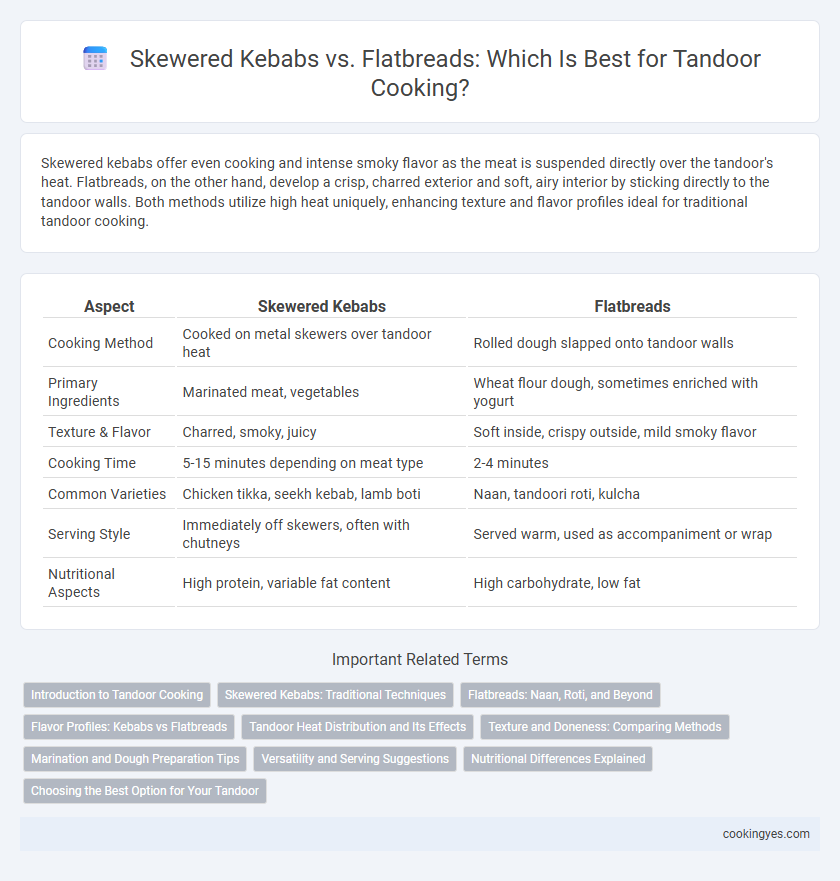Skewered kebabs offer even cooking and intense smoky flavor as the meat is suspended directly over the tandoor's heat. Flatbreads, on the other hand, develop a crisp, charred exterior and soft, airy interior by sticking directly to the tandoor walls. Both methods utilize high heat uniquely, enhancing texture and flavor profiles ideal for traditional tandoor cooking.
Table of Comparison
| Aspect | Skewered Kebabs | Flatbreads |
|---|---|---|
| Cooking Method | Cooked on metal skewers over tandoor heat | Rolled dough slapped onto tandoor walls |
| Primary Ingredients | Marinated meat, vegetables | Wheat flour dough, sometimes enriched with yogurt |
| Texture & Flavor | Charred, smoky, juicy | Soft inside, crispy outside, mild smoky flavor |
| Cooking Time | 5-15 minutes depending on meat type | 2-4 minutes |
| Common Varieties | Chicken tikka, seekh kebab, lamb boti | Naan, tandoori roti, kulcha |
| Serving Style | Immediately off skewers, often with chutneys | Served warm, used as accompaniment or wrap |
| Nutritional Aspects | High protein, variable fat content | High carbohydrate, low fat |
Introduction to Tandoor Cooking
Tandoor cooking involves high-heat clay ovens traditionally used for skewered kebabs and flatbreads, each offering unique cooking benefits. Skewered kebabs, made from marinated meats and vegetables, develop intense smoky flavors and retain juiciness due to direct exposure to the tandoor's radiant heat. Flatbreads like naan and roti cook rapidly on the inner walls of the tandoor, achieving a characteristic char and soft texture essential to authentic tandoori cuisine.
Skewered Kebabs: Traditional Techniques
Skewered kebabs in tandoor cooking utilize traditional techniques that emphasize marination, controlled heat exposure, and precise positioning within the clay oven to achieve tender, smoky flavors. The metal skewers conduct heat evenly, allowing the meat to cook thoroughly while retaining moisture, a method perfected over centuries in Indian and Middle Eastern cuisines. This technique preserves the authentic taste and texture unique to tandoori dishes, distinguishing skewered kebabs from flatbreads in terms of preparation and flavor profile.
Flatbreads: Naan, Roti, and Beyond
Flatbreads such as naan and roti are staples for tandoor cooking, offering a versatile canvas that absorbs smoky flavors while maintaining a soft, chewy texture. Naan, often enriched with yogurt or milk, puffs up with distinct charred spots, while roti provides a lighter, whole-wheat alternative ideal for scooping up rich curries. Beyond traditional types, innovations like stuffed parathas and laccha parathas expand the flatbread repertoire, enhancing the tandoor experience with layered textures and diverse fillings.
Flavor Profiles: Kebabs vs Flatbreads
Skewered kebabs develop intense, smoky flavors from direct exposure to the tandoor's high heat, enhancing the marinade's spices and creating a charred crust that seals in juiciness. In contrast, flatbreads like naan absorb subtle smoky undertones while maintaining a soft, slightly chewy texture, offering a mild, buttery base that complements richer tandoori meats. The distinct flavor profiles stem from kebabs' caramelized spices and tender interiors, whereas flatbreads provide a toasty, slightly tangy contrast, balancing the overall tandoori experience.
Tandoor Heat Distribution and Its Effects
Tandoor heat distribution significantly impacts the cooking of skewered kebabs and flatbreads, with skewers benefiting from the intense, direct radiant heat that ensures even charring and juiciness. Flatbreads, such as naan, rely on the hot clay walls of the tandoor for consistent surface contact, promoting quick puffing and a crisp exterior. Uneven heat zones inside the tandoor can cause variable cooking results, making controlled heat management essential for both kebabs and flatbreads.
Texture and Doneness: Comparing Methods
Skewered kebabs in tandoor cooking achieve a succulent, evenly cooked texture due to direct exposure to intense heat, allowing for precise control of doneness. Flatbreads like naan or roti develop a charred, crispy exterior with a soft, pliable interior by adhering directly to the tandoor walls, creating a contrasting texture to kebabs. Each method optimizes heat distribution uniquely, with skewers ensuring uniform meat cooking and flatbreads emphasizing a balance between crispness and softness.
Marination and Dough Preparation Tips
Marination for skewered kebabs in tandoor cooking requires a blend of yogurt, spices, and acidic ingredients like lemon juice to tenderize the meat and enhance flavor absorption. Flatbreads such as naan demand well-rested dough with a balance of hydration and gluten development to achieve the right elasticity and softness when cooked in the intense heat of the tandoor. Proper marination and dough preparation techniques directly influence the texture and taste, ensuring authentic tandoori results.
Versatility and Serving Suggestions
Skewered kebabs offer exceptional versatility for tandoor cooking, allowing marinated meats, vegetables, and paneer to cook evenly with a smoky char, ideal for serving as appetizers or main dishes. Flatbreads like naan and roti complement the kebabs perfectly, absorbing tandoor-infused flavors and serving as a base for wraps or accompaniments to curries. Combining skewered kebabs and flatbreads creates a balanced meal experience, showcasing traditional Indian flavors with diverse textures and serving options.
Nutritional Differences Explained
Skewered kebabs cooked in a tandoor typically offer higher protein content with lean meats and spices, providing a nutrient-dense meal rich in iron and B vitamins. Flatbreads like naan or roti made in the tandoor primarily supply carbohydrates along with fiber if whole grains are used, contributing to energy intake and digestive health. Combining both in a meal balances macronutrients, enhancing satiety and overall nutritional profile.
Choosing the Best Option for Your Tandoor
Skewered kebabs excel in tandoor cooking by allowing even heat distribution and smoky flavor absorption, making them ideal for well-marinated meats and vegetables. Flatbreads, like naan and roti, benefit from the intense radiant heat of the tandoor walls, resulting in a crispy exterior and soft interior that complements a variety of dishes. Selecting between skewered kebabs and flatbreads depends on your tandoor's temperature control and the desired texture, with kebabs favored for protein-focused meals and flatbreads enhancing the overall dining experience.
Skewered kebabs vs Flatbreads for tandoor cooking Infographic

 cookingyes.com
cookingyes.com